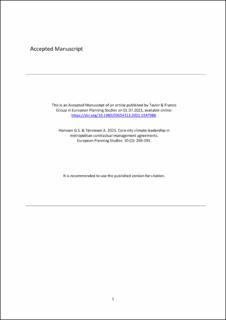| dc.contributor.author | Hanssen, Gro Sandkjær | |
| dc.contributor.author | Tønnesen, Anders | |
| dc.coverage.spatial | Norway | en_US |
| dc.date.accessioned | 2022-06-16T14:46:46Z | |
| dc.date.available | 2022-06-16T14:46:46Z | |
| dc.date.created | 2021-07-29T16:57:24Z | |
| dc.date.issued | 2021-07-01 | |
| dc.identifier.citation | European Planning Studies. 2021, 30 (2), 269-291. | en_US |
| dc.identifier.issn | 0965-4313 | |
| dc.identifier.uri | https://hdl.handle.net/11250/2999101 | |
| dc.description.abstract | Metropolitan governance and planning increasingly are understood as essential in managing urban growth and fostering a sustainable and climate-friendly metropolitan development. Lately, a contractual turn can be observed in metropolitan governance, in which traditional coordination tools are supplemented by contractual management tools between governmental layers and sectors. This article analyses two cases of metropolitan contractual management agreements, one in the Oslo region and one in the Gothenburg region. The article finds that both agreements build on regional strategies and plans to commit national authorities to invest in infrastructure in these metropolitan areas. The Oslo agreement has more layers than the Gothenburg case, in trying to align national, regional and local authorities’ efforts in both land use and mobility politics. The agreements require advanced leadership competence from the core-city, curbing centre-periphery tensions in metropolitan areas and building local alliances to pressure national authorities in agreement negotiations. We argue that this requires a co-creational leadership role, which, in a multilevel governance setting, must be extended to include dimensions such as distributional balance sensitivity, delineation sensitivity and upward pressure. | en_US |
| dc.language.iso | eng | en_US |
| dc.publisher | Taylor and Francis | en_US |
| dc.rights | Attribution-NonCommercial-NoDerivatives 4.0 Internasjonal | * |
| dc.rights.uri | http://creativecommons.org/licenses/by-nc-nd/4.0/deed.no | * |
| dc.title | Core-city climate leadership in metropolitan contractual management agreements | en_US |
| dc.type | Peer reviewed | en_US |
| dc.type | Journal article | en_US |
| dc.rights.holder | © 2021 Informa UK Limited, trading as Taylor & Francis Group | en_US |
| dc.description.version | acceptedVersion | en_US |
| cristin.ispublished | true | |
| cristin.fulltext | preprint | |
| cristin.fulltext | postprint | |
| cristin.qualitycode | 1 | |
| dc.identifier.doi | 10.1080/09654313.2021.1947988 | |
| dc.identifier.cristin | 1923064 | |
| dc.source.journal | European Planning Studies | en_US |
| dc.source.volume | 30 | en_US |
| dc.source.issue | 2 | en_US |
| dc.source.pagenumber | 269-291 | en_US |
| dc.relation.project | Norges forskningsråd: 270668 | en_US |

